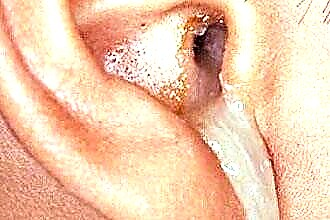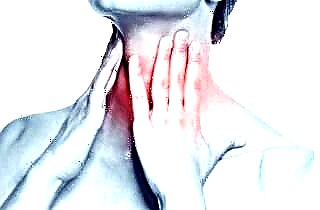Angina, or acute tonsillitis, is one of the most dangerous acute respiratory diseases. Angina is accompanied by severe intoxication and very painful symptoms. With improper treatment, the disease threatens with various complications.
Treatment of acute tonsillitis in most cases is carried out at home or on an outpatient basis, but in severe cases, the patient needs hospitalization.
 The duration of the treatment of angina and the selection of drugs are determined by the etiology of the disease. It is known that bacterial infection is confirmed in 30% of cases of acute tonsillitis, the remaining 70% are caused by viral infections.
The duration of the treatment of angina and the selection of drugs are determined by the etiology of the disease. It is known that bacterial infection is confirmed in 30% of cases of acute tonsillitis, the remaining 70% are caused by viral infections.
Antibiotics are the mainstay of treatment for bacterial sore throat. It depends on the duration of the course of antibiotic therapy how many days a sore throat will have to be treated.
How long does angina take? How long does the standard course of treatment for this disease take? We will tell you what factors determine the duration of therapy for acute tonsillitis and how to speed up recovery.
Clinical picture
Angina is an acute disease of an infectious nature, which is based on inflammation of the tonsils. A synonym for tonsillitis is acute tonsillitis. The provocateur of this pathology is a viral or bacterial infection of the pharyngeal lymphoid ring. Regardless of the causative agent of the infection, the clinical picture of angina includes the following symptoms:
- acute onset of the disease - a sharp deterioration in health, fever, headache, weakness;
- sore throat, worse when swallowing;
- enlargement of the lymph nodes located under the lower jaw;
- loose plaque on the tonsils;
- hyperemia of the pharyngeal ring of lymphoid tissue.
Viral tonsillitis is more common in childhood (most adults have acquired immunity to ARVI viruses). Viral tonsillitis is highly contagious (i.e., infectious); usually proceeds in a mild or moderate form.
Bacterial tonsillitis is less common, but much more dangerous. Firstly, this form of the disease is accompanied by severe intoxication, secondly, it can give complications, and thirdly, the condition threatens to become chronic.
Thus, it is very important to treat angina on time without starting the infectious process.
Treatment of viral and bacterial sore throat
 Since angina is acute, treatment should be started at the first symptoms. This shortens the duration of treatment, reduces the severity of the disease and prevents complications.
Since angina is acute, treatment should be started at the first symptoms. This shortens the duration of treatment, reduces the severity of the disease and prevents complications.
During the acute period of the illness, bed rest should be observed. How many days is angina treated in adults in bed rest?
Adults, as well as children, should spend the first 3 days of illness in bed until the body temperature returns to normal.
Further, the patient can lead a more active lifestyle, but he must continue the prescribed course of treatment and follow the doctor's recommendations for another 4-10 days. During this time, it is necessary to stay at home, therefore it is strongly recommended to issue a temporary disability (sick leave) sheet. In acute tonsillitis, the patient is released from work for 7-10 days (this is how long the standard course of taking antibiotics lasts).
Indeed, antibiotics are an indispensable component in the treatment of angina. It is important to understand that taking antibacterial drugs is justified only if the presence of streptococcal tonsillitis is confirmed.
It is possible to accurately determine the causative agent of the disease using laboratory blood tests (clinical blood test, ASLO) or bacteriological culture of a throat smear.
If the cause of tonsillitis is a virus, local antiseptics form the basis of treatment:
- bioparox (for irrigation of the tonsils);
- pharyngosept (for resorption);
- cameton (for irrigation);
- inhalipt (for irrigation);
- rinsing the mouth and throat with decoctions of medicinal plants (chamomile, calendula, eucalyptus, etc.);
- gargling with antiseptic agents (furacilin, water with the addition of propolis tincture, etc.).
How long is angina treated in adults if it is caused by ARVI? For the treatment of viral tonsillitis, uncomplicated by a bacterial infection, 5-7 days are enough.
Duration of antibiotic therapy
 How long is angina provoked by streptococcal infection treated? It all depends on the duration of the course of antibiotic therapy. Table 1 shows the various antibacterial drugs used in the treatment of angina. As you can see, the course of treatment for most antibiotics is 10 days, but some drugs can overcome the infection much faster.
How long is angina provoked by streptococcal infection treated? It all depends on the duration of the course of antibiotic therapy. Table 1 shows the various antibacterial drugs used in the treatment of angina. As you can see, the course of treatment for most antibiotics is 10 days, but some drugs can overcome the infection much faster.
An antibiotic should be prescribed by a specialist. The choice of a drug depends on many factors:
- the patient's age;
- the sensitivity of the pathogen to a certain class of antibiotics (determined by bacteriological inoculation of a throat swab);
- patient tolerance of the drug components;
- the patient's use of certain antibiotics earlier.
Table 1 Features of the treatment of angina with various antibacterial drugs.
| Antibiotic active ingredient | Synonyms | Dose (per day) | Peculiarities | Well |
| Penicillins | ||||
| Phenoxymethylpenicillin | Vegacillin, Ascillin, Oracillin, Oratren, Phenocillin, Vaucillin, Penbene, Kliatsil, etc. | 0.375 g for children (twice a day); 0, 750 g in 2 divided doses (for adults) | Take 1 hour before meals; there are 2 dosage forms - tablets and suspension. | 10 days |
| Benzathine benzylpenicillin | Retarpen, Extensillin. | 0.6 million units for children, 1.2 million units for adults | The drug is for intramuscular injection. It is prescribed for suspected rheumatism, unfavorable living conditions, as well as during outbreaks of streptococcal infections. | once, rarely twice (1 injection every 7 days) |
| Amoxicillin | Amine, Amoxillate, Apo-Amoxy, Gonoform, Dedoxil, Isoltil, Ospamox, Hikontsil, etc. | 0.125 g 3 times a day (children's dose) 0, 250 mg three times a day (for adults) | Not suitable for patients with infectious mononucleosis, the symptoms of which are similar to angina. | 10 days |
| Cephalosporins | ||||
| Cefadroxil | Cefangin, Cedrox Sandoz, Cedroxandoz, etc. | 1 g in 1-2 doses (with a body weight of 40 kg) | During the course of treatment, the patient should refrain from driving vehicles and other mechanisms. | 10 days |
| Macrolides | ||||
| Erythromycin | Ermycin, Lubomyin, Pantomycinp, Tortrocin, Eracin, Ilozon, Meromycin, Erythromen, Erythroped. | 0.250 g 4-6 times a day | The tablets are taken every 4-6 hours 1-1.5 before meals. In comparison with other modern drugs, erythromycin is more likely to cause side reactions from the gastrointestinal tract. | 10 days |
| Azithromycin | Sumamed, Azivok, Sumazid, Azitrox, ZI-Factor, Zitrolide, Sumamecin, Zitrocin, Hemomycin, etc. | on the 1st day of treatment - 0.5 g; from 2 to 5 days - 0.25 g | It is taken once a day, 1-2 hours before meals. | 5 days |
| Clarithromycin | Klacid, Fromilid, Aziklar, Klerimed, Klabaks, Klarbakt, etc. | 0.25 g twice a day (for children from 12 years old and adults) | The time of admission does not depend on the consumption of food. | 5-14 days |
Duration of treatment for chronic tonsillitis
 Chronic tonsillitis means periodically recurrent bacterial sore throat. In the vast majority of cases, chronic tonsillitis is caused by streptococcal infection.
Chronic tonsillitis means periodically recurrent bacterial sore throat. In the vast majority of cases, chronic tonsillitis is caused by streptococcal infection.
What symptoms indicate the presence of chronic inflammation of the tonsils?
- episodes of sore throat every 2-3 months;
- an increase in the ASLO titer in the blood serum;
- a positive result of bacteriological culture of a smear from the throat on the streptococcal microflora;
- in advanced cases - deterioration of the heart, kidneys and joints (rheumatism).
Antibiotic therapy for chronic tonsillitis involves increasing the daily dose of drugs or lengthening the course of treatment.How long does recurrent tonsillitis take in adults? Table 2 presents the drugs of choice for the treatment of this condition, indicating the estimated duration of the course of treatment.
Table 2 Duration of the course and features of taking antibacterial drugs in the treatment of chronic tonsillitis.
| A drug | Doses of use (per day) | Features of reception | A course of treatment |
| Amoxicillin + clavulanic acid | 40 mg per 1 kg of body weight | in 3 divided doses before meals | 10-14 days |
| Cefuroxime axetil | 20 mg per 1 kg of body weight | in 2 divided doses, immediately after a meal | 10-14 days |
| Clindamycin | 20 mg per 1 kg of body weight | in 3 doses, you need to drink 1-2 glasses of water | 10-14 days |
| Lincomycin | 30 mg per 1 kg of body weight | in 3 divided doses 1-2 hours before eating | 10-14 days |
Thus, the treatment of a sore throat of a viral etiology takes from 4 to 7 days, and a bacterial one - 5-14 days.
In this case, treatment should include local antiseptics (preparations for rinsing, irrigating the throat, resorption), as well as a drug that affects the cause of the disease - infection. With viral tonsillitis, antiviral drugs should be taken from 1 to 5-7 days of illness; with bacterial antibiotics are taken 5-14 days, in accordance with the prescription of the attending physician.



